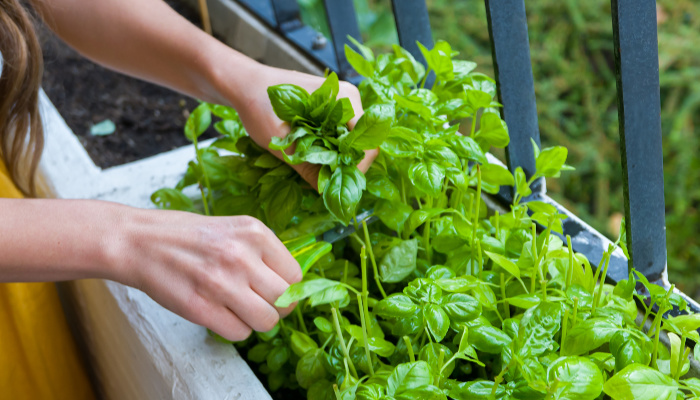Shutterstock

There’s something almost magical about growing a DIY herb garden. Herbs are beautiful, they smell great, and they taste even better. You can easily grow several common herbs in small containers, and they’re surprisingly easy to care for. Before you know it, you’ll have more basil, mint, and rosemary than you know what to do with!
Balconies and patios are great for potted herbs as long as they get enough sun. You could also put a flowerbox outside an accessible window. If all else fails, you can grow some herbs indoors in a sunny room, but they won’t flourish quite as much as their outdoor cousins. Fire escapes might be tempting, but that’s definitely against building safety codes.
Growing plants from seed is rewarding but also difficult. You might be better off stocking up during a sale at your local hardware store or nursery. Farmers markets are also a great source for potted herbs. Plus, you can root new plants of several varieties, like basil, by placing cuttings in water until they sprout roots. Neat, huh?
Basil is one of the easiest to grow in a DIY herb garden. There are a ton of varieties out there—sweet basil, Thai, lemon, purple, cinnamon, and so on. Whenever you feel like it, you can pinch off a few leaves for a salad or dinner dish. Always harvest from the top, not the bottom of the plant.
Rosemary is another easy-care herb. It doesn’t need as much water as basil, but it does require plenty of sunlight. Mint is an incredibly quick grower—in fact, it will take over a garden plot if you let it. But in a pot, a mint plant can keep you in mojitos all summer long.
Any flowering herbs should have their buds nipped before they bloom. If you let your plants “go to seed,” they’ll put all their energy into producing flowers instead of making tasty leaves. You can cut back basil, mint, and chives down to about 2-3 inches during the growing season and see the plants flourish all over again.
Basil need regular pinching, otherwise it grows tall and spindly. Using your fingers, pinch off the top two leaves of the basil stems to encourage them to grow out instead of up.
When you cut back your plants, you’ll need to figure out how you want to use them up. You can quick-dry herbs in a food dehydrator, but my favorite method is to chop up a handful of fresh herbs and pack them into an ice cube tray. Fill up the cavities with olive oil and then freeze. You can pop one of the cubes into a pan for a quick hit of flavor.